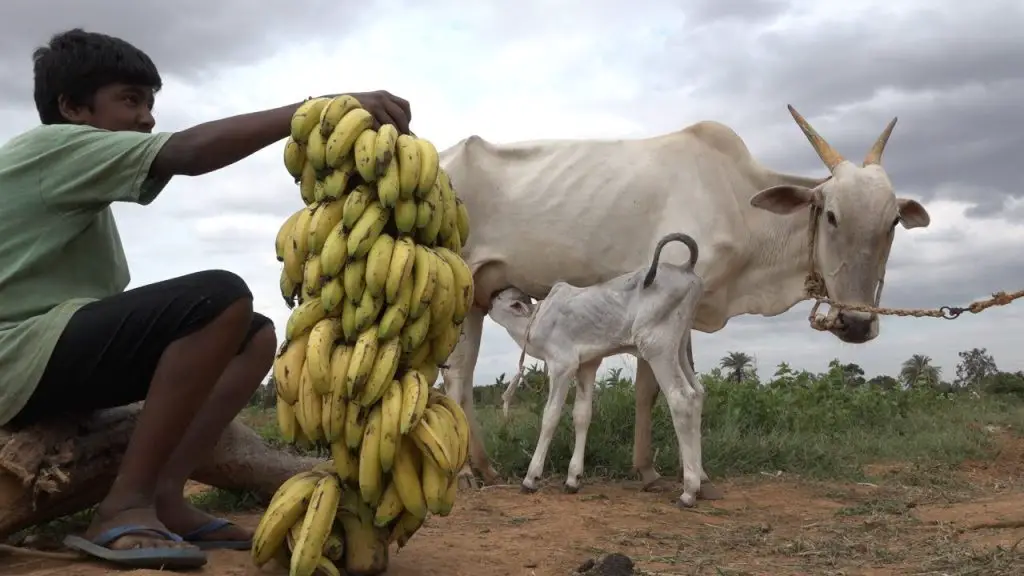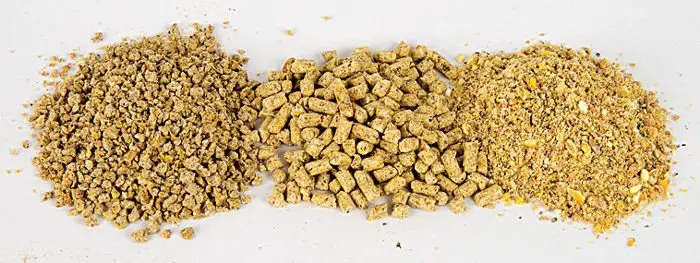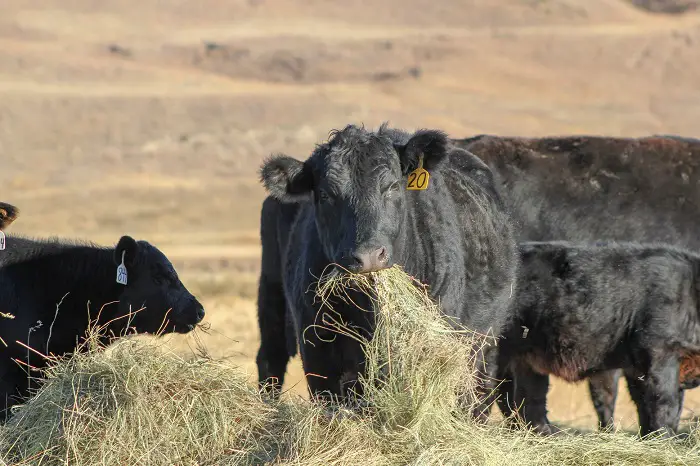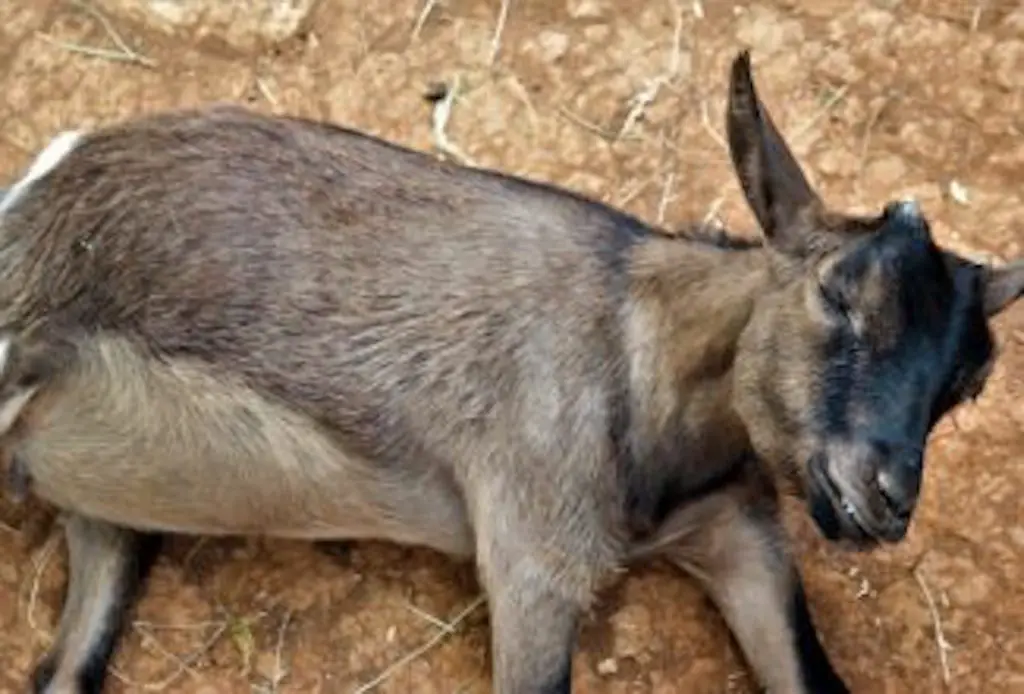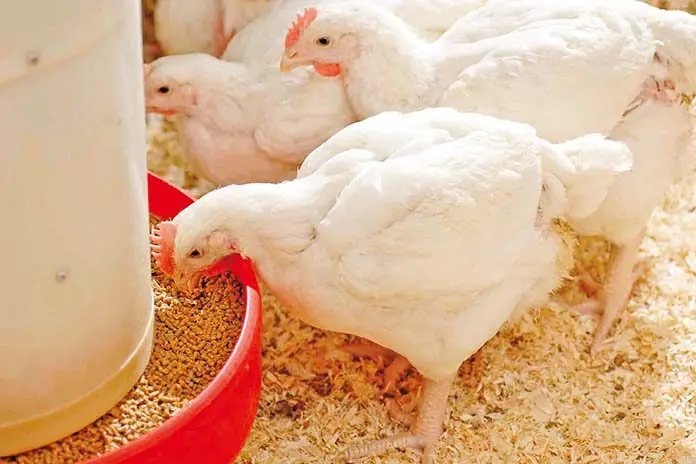Bananas are a common tropical fruit, botanically a berry, that is grown mostly in warm climates where it is consumed raw or cooked. Bananas can be the staple carbohydrate in areas where production is conducive for the high starch varieties commonly known as plantains. Bananas are high in soluble carbohydrates and sugars especially when ripe and are sometime used for beer brewing. Cows can eat bananas utilizing the whole plant from the stems and fruits, it is common practice in the tropics to feed bananas to cows. There are however limitations on how much and how to feed bananas to cows as we shall discuss below.
Contents
Typical Nutritional Profile Bananas
Bananas are typically grown for their fruit which is consumed as desserts, cooked as a carbohydrate source, and used for beer brewing. The stems are used for a wide variety of applications among them feeding ruminant animals like cows, goats, and sheep. Cows can also be fed spoiled or rejected bananas unfit for human consumption supplying energy for rumen fermentation. Bananas are divided into two distinctive groups dessert bananas and cooking bananas mostly termed plantains which are higher in starch than the dessert variety. We will look at the different parts of the banana plant that can be utilized for feeding cows.
Whole fruit
Cows can be fed unripe or overripe bananas that are deemed unfit for human consumption, utilizing any bananas that would have otherwise gone to waste. Worldwide this accounts for about 40% of all bananas produced which are considered unfit for human consumption, which is a considerable amount. These rejected bananas can be fed whole, peeled, ripe or unripe straight to cows, but where there is, excess preservation methods like making silage are employed. Green bananas can be ensiled by combining them with other forage sources such as grass and legumes. Bananas are mostly rich in starch and potassium and very little in other micronutrients especially very low in protein. When whole bananas are fed the skins will provide some fiber especially when the fruit is unripe.
Pseudostems and Leaves
The Pseudostems and leaves can provide significant biomass for feeding to cows hence after the fruit is harvested the stems, and leaves are chopped up and fed to cows. The stems are very succulent being almost 95% water and containing a considerable amount of fiber and very little protein. The leaves do contain some relatively higher protein as compared to the leaves but when these two are fed protein supplements should also be fed to supply protein to the cow. Banana forage does however contain a large quantity of polyphenols which can affect its intake, coupled with the high water content of the forage. Due to the high water content of the leaves and stems ensiling with brans from grain processing can be a viable option when feeding these to cows. The forage can also be dried although this takes a considerable amount of time and effort and might not be that worthwhile.
Peels
In the tropics, banana peels especially from plantains can be available in considerable quantities to warranty including in cow feed. Where considerable quantities are not available banana peels can be fed to cows as snacks. The starch content of banana peels varies with the level of ripeness and variety of the bananas with plantains having higher levels. Protein levels are comparable to those of maize at an average of 8%. The fiber content of banana peels increases with ripening hence plantains, which are mostly consumed when still green have lower fiber levels
Advantages of Feeding Bananas to Cows
As previously mentioned, bananas are a staple in many regions across the globe and a significant quantity of those grown are deemed unfit for human consumption. Almost half of the total world’s production ends up rejected, hence feeding bananas to cows helps reduce pollution. Bananas provide an alternative source of energy apart from traditional grains that are used for cow feeding, this helps produce meat and milk cost-effectively in regions where bananas are grown commercially. The stems and peels can be used as valuable fiber sources and can be incorporated with legume protein sources into a balanced feed for the cows. Trials with milk cows have shown improvements in milk production in cows fed bananas and banana peels.
Constraints of Feeding Bananas to Cows
One of the biggest challenges of feeding bananas to cows is the availability of bananas or stems for cow feeding. Geographically most bananas are grown in the tropics hence only significant amounts of rejects are available in these regions in other parts of the world farmers can get rejects of overripe bananas from supermarkets. Stems are only available for cow feed after the fruits have been harvested is where there is no commercial banana production the supply of stems and leaves can be erratic. The large amount of polyphenols, including tannins, can also be a factor limiting feed intake by cows. Another challenge is the risk of pesticide residues finding their way into the food chain as considerable amounts of pesticides are used in banana production.
How Many Bananas Can a Cow Eat?
Bananas can be fed as a snack to cows on occasion and when available in most parts of the world without affecting their productivity. However, if bananas are adopted as part of a mainstream diet protein supplementation is required as bananas are very low in protein. Whole bananas can make up 50% of the cow’s diet in regions where the bananas are available and at a commercially reasonable cost. Stems and leaves can be included in up to 40% of the diet, however, these inclusions are subject to the cost and availability of the bananas as in some cases it would not make economic sense to feed bananas.
Conclusion
In conclusion, cows can eat bananas, and are loved by cows, as part of a nutritionally balanced diet without any effects on their growth or milk production. A large quantity of bananas is rejected for human consumption, which offers a huge potential feed resource for cows in the tropics where bananas are grown in abundance. The stems and leaves of the banana plant also offer another feed resource for feeding to cows, these can be chopped up fresh, ensiled, and/or dried before feeding to cows. Bananas do contain some antinutritional factors that limit their consumption by cows but can be used as a basal diet for cows and balanced off by protein sources as they are very low in protein.
